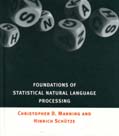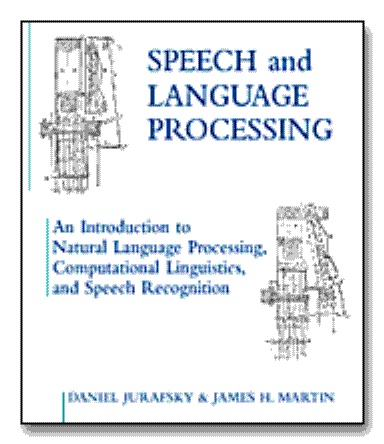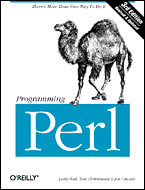


Institute of Formal and Applied Linguistics
Charles University, Czech Republic
Faculty of Mathematics and Physics
NPFL067: Statistical Methods in Natural Language Processing I
About
SIS code: NPFL067
Semester: winter
E-credits: 5
Examination: 2/2 C+Ex
Lecturers: Jan Hajič, hajic@ufal.mff.cuni.cz; Jindrich Helcl, helcl@ufal.mff.cuni.cz
News
This course was discontinued in 2024/2025 and replaced by NPFL147 starting in 2025/2026.
Lecture slides
3. Essential Information Theory Slides
4. Language Modeling (and the Noisy Channel) Slides
5. LM smoothing (and the EM Algorithm) Slides
6. Words and the Company They Keep Slides
7. Mutual Information and Word Classes Slides
8. Word Classes: Programming Tips & Tricks Slides
10. HMM Algorithms: Trellis and Viterbi Slides
11. HMM Parameter Estimation: the Baum-Welch Algorithm Slides
Prerequisites & Relation to Other Courses
Students should have a substantial programming experience in either C, C++, Java and/or Perl, and have preferably taken Data Structures (NTIN060), Unix (NSWI095), and Intro to Probability (NMAI059) or their equivalents, even though all the probability theory needed will be re-explained. Knowledge of, or willingness to learn the basics of Perl as-you-go (and on your own) is also important. One of the benefits of the course is that it is given in English; it should enable you to read current literature on NLP more smoothly, since the literature is almost exclusively in English. Czech terminology will be explained for those interested.
The material covered in this course is selected in such a way that at its completion you should be able to understand papers in the field of Natural Language Processing, and it should also make your life easier when taking more advanced courses either at UFAL MFF UK or elsewhere.
No background in NLP is necessary.
Passing Requirements
To pass the course, students need to complete two homework assignments and pass a written test. See grading for more details.
License
Unless otherwise stated, teaching materials for this course are available under CC BY-SA 4.0.
1. Introduction
2. Probability
3. Essential Information Theory
4. Language Modeling (and the Noisy Channel)
5. LM smoothing (and the EM Algorithm)
6. Words and the Company They Keep
7. Mutual Information and Word Classes
8. Word Classes: Programming Tips & Tricks
9. Markov Models
10. HMM Algorithms: Trellis and Viterbi
11. HMM Parameter Estimation: the Baum-Welch Algorithm
12. Decision trees
Note: The slides are also available as one file in SIS, in two versions: for on-screen viewing (one slide per page) and another file with 4 slides per page for paper-saving printing.
Assignment 1: Exploring Entropy and Language Modeling
Deadline: Nov. 30, 2024, 23:59 100 points
1. Entropy of a Text
In this experiment, you will determine the conditional entropy of the word distribution in a text given the previous word. To do this, you will first have to compute , which is the probability that at any position in the text you will find the word i followed immediately by the word j, and , which is the probability that if word i occurs in the text then word j will follow. Given these probabilities, the conditional entropy of the word distribution in a text given the previous word can then be computed as:
The perplexity is then computed simply as
Compute this conditional entropy and perplexity for the file
This file has every word on a separate line. (Punctuation is considered a word, as in many other cases.) The i,j above will also span sentence boundaries, where i is the last word of one sentence and j is the first word of the following sentence (but obviously, there will be a fullstop at the end of most sentences).
Next, you will mess up the text and measure how this alters the conditional entropy. For every character in the text, mess it up with a likelihood of 10%. If a character is chosen to be messed up, map it into a randomly chosen character from the set of characters that appear in the text. Since there is some randomness to the outcome of the experiment, run the experiment 10 times, each time measuring the conditional entropy of the resulting text, and give the min, max, and average entropy from these experiments. Be sure to use srand to reset the random number generator seed each time you run it. Also, be sure each time you are messing up the original text, and not a previously messed up text. Do the same experiment for mess up likelihoods of 5%, 1%, .1%, .01%, and .001%.
Next, for every word in the text, mess it up with a likelihood of 10%. If a word is chosen to be messed up, map it into a randomly chosen word from the set of words that appear in the text. Again run the experiment 10 times, each time measuring the conditional entropy of the resulting text, and give the min, max, and average entropy from these experiments. Do the same experiment for mess up likelihoods of 5%, 1%, .1%, .01%, and .001%.
Now do exactly the same for the file
which contains a similar amount of text in an unknown language (just FYI, that's Czech [*])
Tabulate, graph and explain your results. Also try to explain the differences between the two languages. To substantiate your explanations, you might want to tabulate also the basic characteristics of the two texts, such as the word count, number of characters (total, per word), the frequency of the most frequent words, the number of words with frequency 1, etc.
Attach your source code commented in such a way that it is sufficient to read the comments to understand what you have done and how you have done it.
Now assume two languages, and do not share any vocabulary items, and that the conditional entropy as described above of a text in language is and that the conditional entropy of a text in language is also . Now make a new text by appending to the end of . Will the conditional entropy of this new text be greater than, equal to, or less than ? Explain (This is a paper-and-pencil exercise of course!)
2. Cross-Entropy and Language Modeling
This task will show you the importance of smoothing for language modeling, and in certain detail it lets you feel its effects.
First, you will have to prepare data: take the same texts as in the previous task, i.e.
TEXTEN1.txt and TEXTCZ1.txt
Prepare 3 datasets out of each: strip off the last 20,000 words and call them the Test Data, then take off the last 40,000 words from what remains, and call them the Heldout Data, and call the remaining data the Training Data.
Here comes the coding: extract word counts from the training data so that you are ready to compute unigram-, bigram- and trigram-based probabilities from them; compute also the uniform probability based on the vocabulary size. Remember ( being the text size, and the vocabulary size, i.e. the number of types - different word forms found in the training text):
Be careful; remember how to handle correctly the beginning and end of the training data with respect to bigram and trigram counts.
Now compute the four smoothing parameters (i.e. "coefficients", "weights", "lambdas", "interpolation parameters" or whatever, for the trigram, bigram, unigram and uniform distributions) from the heldout data using the EM algorithm. (Then do the same using the training data again: what smoothing coefficients have you got? After answering this question, throw them away!) Remember, the smoothed model has the following form:
where
And finally, compute the cross-entropy of the test data using your newly built, smoothed language model. Now tweak the smoothing parameters in the following way: add 10%, 20%, 30%, ..., 90%, 95% and 99% of the difference between the trigram smoothing parameter and 1.0 to its value, discounting at the same the remaining three parameters proportionally (remember, they have to sum up to 1.0!!). Then set the trigram smoothing parameter to 90%, 80%, 70%, ... 10%, 0% of its value, boosting proportionally the other three parameters, again to sum up to one. Compute the cross-entropy on the test data for all these 22 cases (original + 11 trigram parameter increase + 10 trigram smoothing parameter decrease). Tabulate, graph and explain what you have got. Also, try to explain the differences between the two languages based on similar statistics as in the Task No. 2, plus the "coverage" graph (defined as the percentage of words in the test data which have been seen in the training data).
Attach your source code commented in such a way that it is sufficient to read the comments to understand what you have done and how you have done it.
- If you want to see the accents correctly, select ISO Latin 2 coding (charset=iso-8859-2) for viewing, but your programs obviously will (should) work in any case (supposing they are 8-bit clean). You are of course free to convert everything to UTF-8. For those linguistically minded & wishing to learn more about the language, check e.g. https://en.wikipedia.org/wiki/Czech_language. We will be using texts in this language often, albeit you will never be required to learn it.)
Assignment 2: Words and The Company They Keep
Deadline: Feb. 28, 2025, 23:59 100 points
Requirements
For all parts of this homework, work alone. On top of the results/requirements specific to a certain part of the homework, turn in all of your code, commented in such a way that it is possible to determine what, how and why you did what you did solely from the comments, and a discussion/comments of/on the results (in a plain text/html) file. Technically, follow the usual pattern (see below):
1. Best Friends
In this task you will do a simple exercise to find out the best word association pairs using the pointwise mutual information method.
First, you will have to prepare the data: take the same texts as in the previous assignment, i.e.
(For this part of Assignment 2, there is no need to split the data in any way.)
Compute the pointwise mutual information for all the possible word pairs appearing consecutively in the data, disregarding pairs in which one or both words appear less than 10 times in the corpus, and sort the results from the best to the worst (did you get any negative values? Why?) Tabulate the results, and show the best 20 pairs for both data sets.
Do the same now but for distant words, i.e. words which are at least 1 word apart, but not farther than 50 words (both directions). Again, tabulate the results, and show the best 20 pairs for both data sets.
2. Word Classes
The data
Get
These are your data. They are almost the same as the .txt data you have used so far, except they now contain the part of speech tags in the following form:
rady/NNFS2-----A----
,/Z:-------------
where the tag is separated from the word by a slash ('/'). Be careful: the tags might contain everything (including slashes, dollar signs and other weird characters). It is guaranteed however that there is no slash-word.
Similarly for the English texts (except the tags are shorter of course).
The Task
Compute a full class hierarchy of words using the first 8,000 words of those data, and only for words occurring 10 times or more (use the same setting for both languages). Ignore the other words for building the classes, but keep them in the data for the bigram counts and all the formulas that use them (including the Mutual Information, the interim sums in the "Tricks", etc.). For details on the algorithm, use the Brown et al. paper available form SIS; some formulas are wrong in the paper, however, so please see the corrections in the slides (formulas for Trick #4). Note the history of the merges, and attach it to your homework. Now run the same algorithm again, but stop when reaching 15 classes. Print out all the members of your 15 classes and attach them too.
Hints:
The initial mutual information is (English, words, limit 8000):
4.99726326162518 (if you add one extra word at the beginning of the data)
4.99633675507535 (if you use the data as they are and are carefull at the beginning and end).
NB: the above numbers are finally confirmed from an independent source :-).
The first 5 merges you get on the English data should be:
case subject
cannot may
individuals structure
It there
even less
The loss of Mutual Information when merging the words case and subject:
Minimal loss: 0.00219656653357569 for case+subject
3. Tag Classes
Use the same original data as above, but this time, you will compute the classes for tags (the strings after slashes). Compute tag classes for all tags appearing 5 times or more in the data. Use as much data as time allows. You will be graded relative to the other student's results. Again, note the full history of merges, and attach it to your homework. Pick three interesting classes as the algorithm goes (English data only; Czech optional), and comment on them (why you think you see those tags there together (or not), etc.).
Turning in the Assignments
-
Create a separate directory, let's say
myassign1, for your submission. Create a main web page calledindex.htmlorindex.htmin that directory. Create as many other web pages as necessary. Put all the other necessary files (.ps and .pdf files, pictures, source code, ...) into the same directory and make relative links to them from your main or other linked web pages. If you use some "content creation" tools related to MSFT software please make sure the references use the correct case (matching uppercase/lowercase). -
Pack everything into a single
.tgzfile:
cd myassign1
tar -czvf ~/FirstName.LastName.assign.n.tgz ./*
e.g. for Jan Novák and Assignment 2
tar -czvf ~/Jan.Novak.assign.2.tgz ./* -
Send the resulting file by e-mail (as an attachment) to BOTH
hajic@ufal.mff.cuni.czANDhelcl@ufal.mff.cuni.cz
with the following subject line:
Subject: FirstName.LastName NPFL067 Assignment n
e.g. for Jan Novák and Assignment 2
Subject: Jan.Novak NPFL067 Assignment 2
Unix lab accounts
MFF UK students should already have their accounts for the lab. For others, please visit https://www.ms.mff.cuni.cz/students/externisti.html.en.
Grades
-
The grading table is available in SIS.
-
The final grade (or pass/fail for PhD students) will be determined by the final exam and points received on your assignments, in a 1/3 : 1/3 : 1/3 ratio.
Exam
-
The exam is written (not oral), with about 4-5 major questions and some subquestions. You will have 60 minutes to write down the answers.
-
To get an idea of the type of exam questions, please see the questionaire for one of the previous year's final exam (Questionnaire).
Plagiarism
No plagiarism will be tolerated. The assignments is to be worked on your own; please respect it. If the instructor determines that there are substantial similarities exceeding the likelihood of such an event, he will call the two (or more) students to explain them and possibly to take an immediate test (or assignment(s), at the discretion of the instructor, not to exceed four hours of work) to determine the student's abilities related to the offending work. All cases of confirmed plagiarism will be reported to the Student Office.
Lateness
-
For each day your submission is late, 5 points will be subtracted from the points awarded to the solution or a part of it, up to max. of 50 points per homework.
-
Submissions received less then 4 weeks before the closing date of the term will not be graded and will be awarded 0 points.
Required Reading
Foundations of Statistical Natural Language Processing
Manning, C. D. and H. Schütze. MIT Press. 1999. ISBN 0-262-13360-1.
Eight copies of this book are available at the CS library for borrowing. Please be considerate to other students and do not keep the book(s) longer than absolutely necessary.
Recommended & Reference Readings
Speech and Language Processing
Jurafsky, D. and J. H. Martin. Prentice-Hall. 2000. ISBN 0-13-095069-6.
Three copies of Jurafsky's book are available at UFAL's library.
Programming PERL
Wall, L., Christiansen, T. and R. L. Schwartz. O'Reilly. 1996. ISBN 0-596-00027-8.
(Sorry no large cover picture available.)
Natural Language Understanding
Allen, J.. Benajmins/Cummings Publishing Company 1994. ISBN 0-8053-0334-0.
Elements of Information Theory
Cover, T. M. and J. A. Thomas. Wiley. 1991. ISBN 0-471-06259-6.
Statistical Language Learning
Charniak, E. MIT Press. 1996. ISBN 0-262-53141-0.
Statistical Methods for Speech Recognition
Jelinek, F. MIT Press. 1998. ISBN 0-262-10066-5.
Four copies of Jelinek's book are available at UFAL's library, but they are primarily reserved for those taking Nino Peterek's and/or Filip Jurcicek's courses.
Proceedings of major conferences (related to Natural Language Processing)
Some of the Proceedings are available at UFAL's library, physically and/or in electronic form. Most of them are, however, freely available through the ACL Anthology, including all volumes of the Computational Linguistics journal and the new Transactions of the ACL journal.
- ACL (Association of Computational Linguistics)
- European Chapter of the ACL
- North American Chapter of the ACL
- EMNLP (Empirical Methods in Natural Language Processing)
- COLING (International Committee of Computational Linguistics)
- ANLP (Applied Natural Language Processing, by ACL)
- ACL SIGDAT, other SIG (Special Interest Groups) Workhops, such as WVLC (Workshop on Very - Large Corpora)
- DARPA HLT (Defense Advanced Research Project Agency Human Language Technology Workshops)
Other Resources
-
CLSP Workshops: Language Engineering for Students and Professionals Integrating Research - and Education







